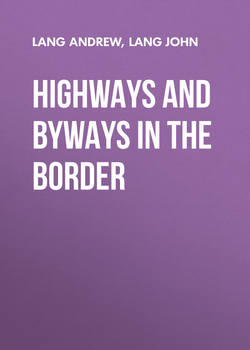Читать книгу Highways and Byways in the Border - Lang Andrew, May Kendall - Страница 5
CHAPTER IV JEDBURGH, AND THE JED
ОглавлениеTwo or three miles up Teviot from the junction of Oxnam Water, we come to Jed, a beautiful stream, on whose banks dreams the pleasant county town where, close on ninety years ago, they cried that cry of which they do not now like to think – "Burke Sir Walter!"
In all the Border there stands no place more picturesquely situated than Jedburgh, nor in historical interest can any surpass it. And though its ancient castle, and the six strong towers that once defended the town, have long since vanished, there remain still the noble ruins of its magnificent abbey, and other relics of the past, less noticeable but hardly less interesting; whilst the surrounding countryside brims over with the beauty of river, wood, and hill.
History gives no very definite information as to the date at which first took place the building of a castle at Jedburgh, but it appears certain that as early as the year 950 a.d. there existed in these parts some great stronghold, if, at least, "Judan-byrig" – where, when he had suppressed an insurrection in Northumbria, King Edred of England confined the rebel Archbishop of York – may be identified with "Jedburgh." Probably, however, there was in this neighbourhood a castle of sorts long prior to the date above mentioned, for both "Gedde-wrdes," or "Jedworths," the old and the new, were known settlements before the expiry of the earlier half of the ninth century, and in those turbulent days no community was rash enough to plant itself in hamlet or town except under the protecting shield of castle or strong place of arms.
In any case, before the end of the eleventh century, there certainly existed at Jedburgh a castle of formidable strength, which at frequent intervals continued to be used by the Scottish kings as a royal residence. Here, in 1165, died Malcolm the Maiden. From Jedvvorth was issued many a Charter by Malcolm's predecessor, David I, by William the Lion, by Alexander II. Here, too, the queen of Alexander III bore him a son in the year 1264; and here at a masque held after Alexander's second marriage in 1285, appeared and vanished the grizzly skeleton that danced a moment before the king, threading its ghastly way through the ranks of dismayed guests; frightened women shrank screaming from its path, men brave to face known dangers yet fell back from this horror, hurriedly crossing themselves. An evil omen, they said, a presage of misfortune or of death to the highest in the land. And surely the portent was borne out, for less than six months saw Scotland mourning the violent death of her King.
Like its not distant neighbour, the more famed castle of Roxburgh, Jedburgh castle as time went on became a stronghold continually changing hands; to-day garrisoned by Scots, to-morrow held by English, taken and retaken again and again, too strong and of importance too great to be anything but a continuous bone of contention between the two nations, yet more often, and for longer periods, in English than in Scottish keeping. When in the summer of the year 1316, King Robert the Bruce went to Ireland, Sir James Douglas was one of the wardens left by him in charge of the Scottish Kingdom. Jedburgh Castle, probably with a garrison far from strong, was then in English keeping. Douglas established himself at Lintalee, little more than a mile up the river from Jedburgh, where, by throwing across the neck of a promontory between the river and a precipitous glen, fortifications which even now are not quite destroyed, he converted a post of great natural strength into a position almost unassailable. Here, or in the immediate neighbourhood, in 1317 he inflicted two severe defeats on separate bodies of English troops, detachments from a larger army under the Earl of Arundel. As the outcome of these victories, Jedburgh Castle was probably regained by the Scots, for the English monks in Jedburgh Abbey were expelled by their Scottish brethren in February, 1318, a step they would scarcely have dared to attempt had an English garrison still been in the castle. In 1320 town and castle were bestowed by the Bruce on Sir James Douglas, and five years later the grant was confirmed, with further additions of land. But in 1334 Edward Baliol, who two years earlier had assumed the Crown of Scotland, handed over to King Edward III, to remain for ever in the possession of England, amongst other places, the town, castle, and forest of Jedworth. These Edward now bestowed on Henry Percy, thus providing ground for a very pretty quarrel between the Douglases and Percies. From now onward, practically for seventy-five years, Jedburgh Castle remained in English hands.
